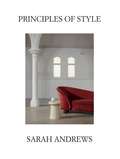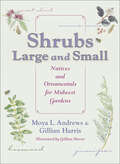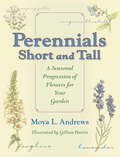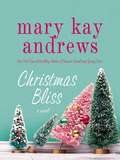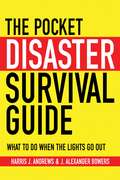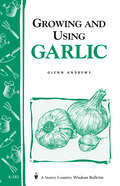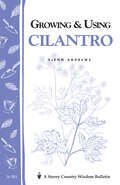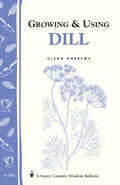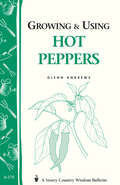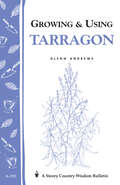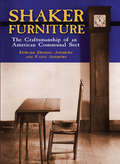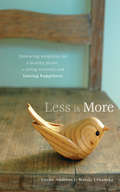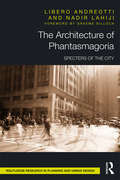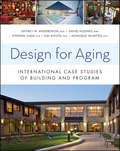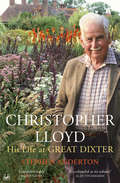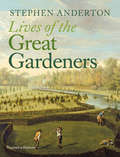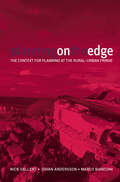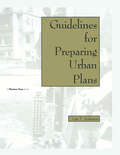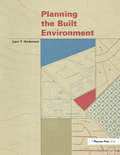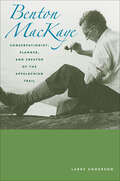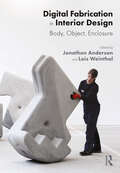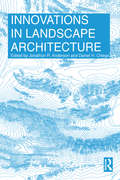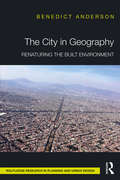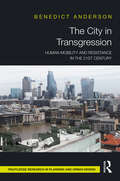- Table View
- List View
Principles of Style
by Sarah AndrewsIn Principles of Style, Sarah Andrews presents her unique take on teaching design, drawing on her experience of working in the industry and as a teacher in her school, which has reached cult status around the world. Importantly, Principles of Style aims to be a timeless learning tool for readers, no matter their own personal style, with Sarah revealing many of the ideas, tips and skills she has accumulated along the way. She does this by examining some of her key projects and favourite rooms, as well as by focusing on her ten rules of styling, formulated both through hands-on experience and studies in the science of design. Sarah believes that everyone has the ability to create interiors that are right for them; in this inspiring and eminently practical book, she aims to demonstrate just how to do so.
Shrubs Large and Small: Natives and Ornamentals for Midwest Gardens
by Moya L. Andrews Gillian HarrisA charming and colorful guide to the hardy, low-maintenance plants that serve as essential elements of the architecture of our gardens.This beautifully illustrated book on landscape gardening addresses shrubs and how to determine which you should plant among your perennials and where. Shrubs provide the foundation for a pleasing, yet low-maintenance garden. They are long-lived, have the ornamental appeal of perennials, and provide variety in color, size, shape, and texture, as well as shelter and berries for birds. Shrubs can make attractive arrangements indoors and provide seasonal variation through the entire year.In addition to the useful information for gardeners of any skill level, Shrubs Large and Small includes Gillian Harris’s irresistible illustrations—botanically correct works of art that will delight and inspire.
Perennials Short and Tall: A Seasonal Progression of Flowers for Your Garden
by Moya L. Andrews“Beginning and novice gardeners will find this book invaluable . . . a colorful palette of well known, dependable plants listed in bloom order.” —Carolyn Harstad, author of Got Sun?Designed for accessibility, this book offers tried-and-true advice on how to keep a yard in bloom. Presented in the sequence in which they bloom, with a chapter devoted to each of the three major growing seasons, 25 varieties of flowers are profiled with accompanying color illustrations. Additionally, Moya L. Andrews provides information about such basic topics as bed preparation, planting locations, weed control, and landscape principles. Andrews also offers practical tips on propagating, transplanting, and dividing perennials, as well as aesthetic considerations such as the use of color outdoors and flower arranging with cut blossoms. Suggestions for flower arrangement and producing indoor blooms in the winter months are also included.“The text descriptions for each of the flowers mentioned, and illustrations of most of the flowers by bloom sequence through the seasons, fills a vacancy in the gardening book market.” —Ezra Haggard, author of Trees, Shrubs, and Roses for Midwest Gardens“Writing in an informative, yet casual style, Moya Andrews gives advice on growing flowering perennials in this guide for both novice and experienced gardeners, passing along her broad knowledge of the subject.” —Chicago Botanic Garden Journal
Christmas Bliss (Weezie and BeBe Mysteries #4)
by Mary Kay AndrewsChristmas is coming, but Savannah antique dealer Weezie Foley is doubly distracted-both by her upcoming wedding to her longtime love, chef Daniel Stipanek and also by the fact that her best friend and maid-of-honor BeBe Loudermilk is due to give birth any day-and is still adamantly refusing to marry her live-in-love Harry. Readers have come to love these characters in Mary Kay Andrews' three previous Savannah novels: Savannah Blues, Savannah Breeze,  and Blue Christmas. Christmas Bliss offers Andrews's legions of fans the best of many things: familiar characters, a new novella for Christmas, and a celebration of Mary Key Andrews's own favorite pastime-antiquing. Blue Christmas was a fan favorite, and now Christmas Bliss is sure to fly off store shelves and into the hands of Andrews's fans in bestselling numbers. Look for the following books by Mary Kay Andrews also writing as Kathy Hogan Trocheck, in the Bookshare collection: Ladies' Night, Spring Fever, Summer Rental, The Fixer Upper, Deep Dish, Blue Christmas, Savannah Breeze, Hissy Fit, Little Bitty Lies, Savannah Blues and many more.
The Pocket Disaster Survival Guide: What to Do When the Lights Go Out
by Harris J. Andrews J. Alexander BowersWhether it’s a hurricane bearing down on a home near the coast or a power line downed in a snowstorm near a car, are you prepared for these situations? This slim handbook will provide you with all the information you need to ensure that you, your family, and your pets can weather any emergency crisis. Learn the necessity of backing up important documents, how to safely store food and water for more than a day, and how to communicate with your family and emergency personnel should a disaster strike.
Growing And Using Garlic
by Glenn AndrewsThe first third of the booklet is a brief guide to growing garlic and the remainder is recipes.
Growing and Using Garlic: Storey's Country Wisdom Bulletin A-183 (Storey Country Wisdom Bulletin Ser.)
by Glenn AndrewsSince 1973, Storey's Country Wisdom Bulletins have offered practical, hands-on instructions designed to help readers master dozens of country living skills quickly and easily. There are now more than 170 titles in this series, and their remarkable popularity reflects the common desire of country and city dwellers alike to cultivate personal independence in everyday life.
Growing & Using Cilantro: Storey's Country Wisdom Bulletin A-181 (Storey Country Wisdom Bulletin Ser.)
by Glenn AndrewsSince 1973, Storey's Country Wisdom Bulletins have offered practical, hands-on instructions designed to help readers master dozens of country living skills quickly and easily. There are now more than 170 titles in this series, and their remarkable popularity reflects the common desire of country and city dwellers alike to cultivate personal independence in everyday life.
Growing & Using Dill: Storey's Country Wisdom Bulletin A-200 (Storey Country Wisdom Bulletin Ser.)
by Glenn AndrewsSince 1973, Storey's Country Wisdom Bulletins have offered practical, hands-on instructions designed to help readers master dozens of country living skills quickly and easily. There are now more than 170 titles in this series, and their remarkable popularity reflects the common desire of country and city dwellers alike to cultivate personal independence in everyday life.
Growing & Using Hot Peppers: (Storey's Country Wisdom Bulletin A-170) (Storey Publishing Bulletin Ser. #Vol. A-170)
by Glenn AndrewsSince 1973, Storey's Country Wisdom Bulletins have offered practical, hands-on instructions designed to help readers master dozens of country living skills quickly and easily. There are now more than 170 titles in this series, and their remarkable popularity reflects the common desire of country and city dwellers alike to cultivate personal independence in everyday life.
Growing & Using Tarragon: Storey's Country Wisdom Bulletin A-195 (Storey Country Wisdom Bulletin Ser.)
by Glenn AndrewsSince 1973, Storey's Country Wisdom Bulletins have offered practical, hands-on instructions designed to help readers master dozens of country living skills quickly and easily. There are now more than 170 titles in this series, and their remarkable popularity reflects the common desire of country and city dwellers alike to cultivate personal independence in everyday life.
Shaker Furniture
by Edward D. Andrews48 sharp photos show side chairs, long benches, rocking chairs, chests, cupboards, much more. Exact measurements given for each piece to aid in identification, reconstruction, restoration. Also--highly readable commentary on sect's cultural background.
Less is More
by Cecile Andrews Wanda Urbanska"it is a series of hard-hitting essays by a diverse collection of writers that wraps its arms around everything from simplicity to climate change to economic metrics to happiness. I approached each chapter (each new writer) with skepticism and a willingness to put the book down, and I found my self delighted time after time. This is a book anyone would be glad to have on their shlf." - Lyle Estill "Here is a book with its roots in the earth that can move you to new places, stimulate ideas and encourage change. Less is More will show you how to divest gradually, to live more in the present moment, while still paying attention to technology, health, politics and the environment. Simplicity is not a turning away. It is a rejoining." Barbara Bamberger Scott "The anthology's true strength comes in the diversity of its voices - which include not only journalists and activists, but also businesspeople and ministers. Less is More will serve as an informative and inspiring primer." - Ryan Williams, ForeWord Magazine "Andrews and Urbanska are masterful in their prose and their ability to bring together an eclectic array of writers, thinkers and sustainability adovcates who live in ways that echo what they write about. " John Ivanko "No good idea stays local for long," writes Jay Walljaspsr in Less is More, a smart collection of essays that chant the simplicity mantra without oversimpifying the issues at stake. Many of these ideas seem bound to travel far." - Utne Reader "I am both educated and inspired by the writings in Less is More. Living simply, like finding the heart, is the work of a lifetime. It is not easy to get there, but it provides a life of ease once the goal is reached. This book is a wonderful contribution to reorienting our lives away from the alienating influences of our shame-inducing consumer culture back toward what is really important: the choice to care for ourselves, others and the planet in a simple, loving way." - Glenn Berger, PhD, glennbergerblog People are afraid and anxious. We're destroying the planet, undermining happiness, and clinging to an unsustainable economy. Our obsessive pursuit of wealth isn't working. But there's another way. Less can be More. Throughout history wise people have argued that we need to live more simply--that only by limiting outer wealth can we have inner wealth. Less is More is a compelling collection of essays by people who have been writing about simplicity for decades. They bring us a new vision of Less: less stuff, less work, less stress, less debt. A life with Less becomes a life of More: more time, more satisfaction, more balance, and more security. When we have too much, we savor nothing. When we choose less, we regain our life and can think and feel deeply. Ultimately, a life of less connects us with one true source of happiness: being part of a caring community. Less is More shows how to turn individual change into a movement that leads to policy changes in government and corporate behavior, work hours, the wealth gap, and sustainability. It will appeal to those who want to take back their lives, their planet, and their well-being.
The Architecture of Phantasmagoria: Specters of the City
by Libero Andreotti Nadir LahijiIn a time of mass-mediated modernity, the city becomes, almost by definition, a constitutively ‘mediated’ city. Today, more than ever before, the omnipresence of media in every sphere of culture is creating a new urban ontology, saturating, fracturing, and exacerbating the manifold experience of city life. The authors describe this condition as one of 'hyper-mediation' – a qualitatively new phase in the city’s historical evolution. The concept of phantasmagoria has pride of place in their study; using it as an all-embracing explanatory framework, they explore its meanings as a critical category to understand the culture, and the architecture, of the contemporary city. Andreotti and Lahiji argue that any account of architecture that does not include understanding the role and function of media and its impact on the city in the present ‘tele-technological-capitalist’ society is fundamentally flawed and incomplete. Their approach moves from Walter Benjamin, through the concepts of phantasmagoria and of media – as theorized also by Theodor Adorno, Siegfried Kracauer, and a new generation of contemporary critics – towards a new socio-critical and aesthetic analysis of the mediated space of the contemporary city.
Design for Aging
by Jeffrey Anderzhon Faia David Hughes Riba Stephen Judd Emi Kiyota Monique Wintjies B. O. T.Architecture/Interior Design An in-depth look at the most innovative aged care facilities today With the world's population aging at a rapid pace, there is a growing need for new ways to provide residential care for older people. Design for Aging explores some of the most successful examples of elderly housing today, focusing on integrating architectural considerations within an unwavering people-driven approach. Written by an international team of experts in aged care design, the book brings together twenty-six case studies from around the world, including Australia, Denmark, England, Japan, the Netherlands, Sweden, and the United States. The authors describe how each scheme has succeeded in addressing the needs of its residents regardless of wide variations in design, geography, cultural factors, medical needs, capital cost, and other factors. Clear, well-documented information for each facility includes: Building descriptions and project data, and how the overall design fits within a geographical location The type of community, including number of residents, ethnicity, and specific conditions such as dementia How to apply universal design principles in different political, social, and regulatory contexts How to create a sense of belonging and well-being for residents while building strong connections with the community at large What makes a facility able to attract and retain high-quality caregivers Environmental sustainability issues, plus indoor and outdoor spaces Architects and interior designers as well as facility owners and caregivers will find Design for Aging an inspiring and practical guide on how to navigate the many factors involved in creating good designs for aged care environments.
Christopher Lloyd: His Life at Great Dixter
by Stephen AndertonChristopher Lloyd (Christo) was one of the greatest English gardeners of the twentieth century, perhaps the finest plantsman of them all. His creation is the garden at Great Dixter in East Sussex, and it is a tribute to his vision and achievement that, after his death in 2006, the Heritage Lottery Fund made a grant of £4 million to help preserve it for the nation. This enjoyable and revealing book - the first biography of Christo - is also the story of Dixter from 1910 to 2006, a unique unbroken history of one English house and one English garden spanning a century. It was Christo's father, Nathaniel, who bought the medieval manor at Dixter and called in the fashionable Edwardian architect, Lutyens, to rebuild the house and lay out the garden. And it was his mother, Daisy, who made the first wild garden in the meadows there. Christo was born at Dixter in 1921. Apart from boarding school, war service and a period at horticultural college, he spent his whole life there, constantly re-planting and enriching the garden, while turning out landmark books and exhaustive journalism. Opinionated, argumentative and gloriously eccentric, he changed the face of English gardening through his passions for meadow gardening, dazzling colours and thorough husbandry. As the baby of a family of six - five boys and a girl - Christo was stifled by his adoring mother. Music-loving and sports-hating, he knew the Latin names of plants before he was eight. This fascinating book reveals what made Christo tick by examining his relationships with his generous but scheming mother, his like-minded friends (such as gardeners Anna Pavord and Beth Chatto) and his colleagues (including his head gardener, Fergus Garrett, a plantsman in Christo's own mould).
Lives of the Great Gardeners
by Stephen AndertonEntertaining and accessible—the lives of the men and women, many of them multitalented artists, who created some of the world’s most extraordinary gardens, and whose legacy continues to inspire Throughout history, great gardeners have risen from all walks of life. Some have been aristocratic amateur gardeners, others professional designers with an international practice. Some have come to garden-making from sculpture or painting; some have been hands-on nurserymen or botanists. What they all have in common is the ability to take an idea and develop it to meet the needs and aesthetics of their times. The book is organized into four thematic sections. Gardens of Ideas moves from the politically allusive gardens of eighteenth-century England to Charles Jencks’s Scottish garden inspired by twenty-first-century cosmography. Gardens of Straight Lines explores the lives of the great formalist gardeners, from Le Nôtre at Versailles to the rational English minimalism of contemporary designer Christopher Bradley-Hole. Gardens of Curves opens with that great exponent of the English landscape garden, “Capability” Brown, and moves on to the extraordinary Brazilian designer Roberto Burle Marx. Finally, Gardens of Plantsmanship arcs from the father of naturalistic planting, William Robinson, to the sweeping prairie-style of Piet Oudolf. With images of gardens as they were originally seen, together with portraits of their makers and an outstanding text by the award-winning gardens writer for The Times, this book will appeal to garden lovers everywhere.
Planning on the Edge
by Johan Andersson Nick Gallent Marco BianconiMore than a tenth of the land mass of the UK comprises 'urban fringe': the countryside around towns that has been called 'planning's last frontier'. One of the key challenges facing spatial planners is the land-use management of this area, regarded by many as fit only for locating sewage works, essential service functions and other un-neighbourly uses. However, to others it is a dynamic area where a range of urban and rural uses collide. Planning on the Edge fills an important gap in the literature, examining in detail the challenges that planning faces in this no-man’s land. It presents both problems and solutions, and builds a vision for the urban fringe that is concerned with maximising its potential and with bridging the physical and cultural rift between town and country. Its findings are presented in three sections: the urban fringe and the principles underpinning its management sectoral challenges faced at the urban fringe (including commerce, energy, recreation, farming, and housing) managing the urban fringe more effectively in the future. Students, professionals and researchers alike will benefit from the book's structured approach, while the global and transferable nature of the principles and ideas underpinning the study will appeal to an international audience.
Guidelines for Preparing Urban Plans
by Larz AndersonWhile many authors have written about what urban plans should contain and how they should be used, this comprehensive book leads you step by step through the entire plan preparation process. Citing examples from across the country, Larz Anderson shows how to prepare, review, adopt, and implement urban plans. He explains how to identify public needs and desires, analyze existing problems and opportunities, and augment long-range general plans with short-range district and function plans. Anderson presents these guidelines as tasks. For each task, he explains the rationale behind it, recommends a procedure for completing it, and identifies the expected results. Throughout, Anderson encourages improvisation — he urges planners to adapt the guidelines to meet local needs. Excerpts from recently adopted general plans illustrate Anderson's points and provide examples of variations even within his recommendations. A related glossary gives comprehensive definitions to words that, though not technical, have meanings specific to the urban plan.
Planning the Built Environment
by Larz AndersonPlanning the Built Environment takes a systematic, technical approach to describing how urban infrastructures work. Accompanied by detailed diagrams, illustrations, tables, and reference lists, the book begins with landforms and progresses to essential utilities that manage drainage, wastewater, power, and water supply. A section on streets, highways, and transit systems is highly detailed and practical. Once firmly grounded in these "macro" systems, Planning the Built Environment examines the physical environments of cities and suburbs, including a discussion of critical elements such as street and subdivision planning, density, and siting of community facilities. Each chapter includes essential definitions, illustrations and diagrams, and an annotated list of references. This timely book explains new physical planning methods and current thinking on cluster development, new urbanism, and innovative transit planning and development. Planners, architects, engineers, and anyone who designs or manages the physical components of urban areas will find this book both an authoritative reference and an exhaustive, understandable technical manual of facts and best practices. Instructors in planning and allied fields will appreciate the practical exercises that conclude each chapter: valuable learning tools for students and professionals alike.
Benton MacKaye: Conservationist, Planner, and Creator of the Appalachian Trail (Creating the North American Landscape)
by Larry AndersonPlanner and originator of the Appalachian Trail and a cofounder of the Wilderness Society, Benton MacKaye (1879-1975) was a pioneer in linking the concepts of preservation and recreation. Spanning three-quarters of a century, his long and productive career had a major impact on emerging movements in conservation, environmentalism, and regional planning. MacKaye's seminal ideas on outdoor recreation, wilderness protection, land-use planning, community development, and transportation have inspired generations of activists, professionals, and adventurers seeking to strike a harmonious balance between human need and the natural environment.This pathbreaking biography provides the first complete portrait of this significant and unique figure in American environmental, intellectual, and cultural history. Drawing on extensive research, Larry Anderson traces MacKaye's extensive career, examines his many published works, and describes the importance of MacKaye's relationships with such influential figures as Lewis Mumford, Aldo Leopold, and Walter Lippmann. This book will appeal to students, scholars, and professionals in preservation, conservation, recreation, planning, and American studies, as well as general readers interested in these subjects.
Digital Fabrication in Interior Design: Body, Object, Enclosure
by Jonathon Anderson Lois WeinthalDigital Fabrication in Interior Design: Body, Object, Enclosure draws together emerging topics of making that span primary forms of craftsmanship to digital fabrication in order to theoretically and practically analyze the innovative and interdisciplinary relationship between digital fabrication technology and interior design. The history of making in interior design is aligned with traditional crafts, but a parallel discourse with digital fabrication has yet to be made evident. This book repositions the praxis of experimental prototyping and integrated technology to show how the use of digital fabrication is inherent to the interior scales of body, objects and enclosure. These three scales act as a central theme to frame contributions that reinforce the interdisciplinary nature of interior design and reinterpret traditional crafts by integrating new methods of making into conventional workflows. Featuring significant international practitioners and researchers, the selected contributions represent the ever-increasing interdisciplinary nature of design, demonstrating a breadth of disciplines. A foundational text for interiors students and practitioners, Digital Fabrication in Interior Design expands the necessary dialogue about digital fabrication at the scale of interiors to inform design theory and practice.
Innovations in Landscape Architecture
by Jonathon R. Anderson Daniel H. OrtegaThis inspiring and thought-provoking book explores how recent innovations in landscape architecture have uniquely positioned the practice to address complex issues and technologies that affect our built environment. The changing and expanding nature of "landscape" make it more important than ever for landscape architects to seek innovation as a critical component in the forward development of a contemporary profession that merges expansive ideas and applications. The editors bring together leading contributors who are experts in new and pioneering approaches and technologies within the fields of academic and professional landscape architecture. The chapters explore digital technology, design processes and theoretical queries that shape the contemporary practice of landscape architecture. Topics covered include: Digital design Fabrication and prototyping Emerging technology Visualization of data System theory Concluding the book are case studies looking at the work of two landscape firms (PEG and MYKD) and two academic departments (Illinois Institute of Technology and the Rhode Island School of Design), which together show the novel and exciting directions that landscape is already going in.
The City in Geography: Renaturing the Built Environment
by Benedict AndersonMonumental in scale and epic in development, cities have become the most visible and significant symbol of human progress. The geography on and around which they are constructed, however, has come to be viewed merely in terms of its resources and is often laid to waste once its assets have been stripped. The City in Geography is an urban exploration through this phenomenon, from settlement to city through physical geography, which reveals an incremental progression of removing terrain, topography and geography from the built environment, ushering in and advancing global destruction and instability. This book explains how the fall of geography in relationship to human survival has come through the loss of contact between urban dwellers and physical terrain, and details the radical rethinking required to remedy the separations between the city, its inhabitants and the landscape upon which it was built.
The City in Transgression: Human Mobility and Resistance in the 21st Century
by Benedict AndersonThe City in Transgression explores the unacknowledged, neglected, and ill-defined spaces of the built environment and their transition into places of resistance and residence by refugees, asylum seekers, migrants, the homeless, and the disadvantaged. The book draws on urban and spatial theory, socio-economic factors, public space, and architecture to offer an intimate look at how urban sites and infrastructure are transformed into spaces for occupation. Anderson proposes that the varied innovations and adaptations of urban spaces enacted by such marginalized figures – for whom there are no other options – herald a radical new spatial programming of cities. The book explores cities and sites such as Mexico City and London, the Mexican/US border, the Calais Jungle, and Palestinian camps in Beirut and utilizes concepts associated with ‘mobility’ – such as anarchy, vagrancy, and transgression – alongside photography, 3D modelling, and 2D imagery. From this constellation of materials and analysis, a radical spatial picture of the city in transgression emerges. By focusing on the ‘underside of urbanism’, The City in Transgression reveals the potential for new spatial networks that can cultivate the potential for self-organization so as to counter the existing dominant urban models of capital and property and to confront some of the major issues facing cities amid an age of global human mobility. This book is valuable reading for those interested in architectural theory, modern history, human geography and mobility, climate change, urban design, and transformation.
